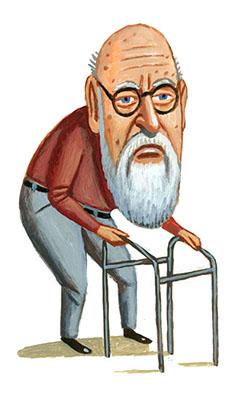Humanity’s increase in lifespan may be our greatest achievement. Most of the world’s children and their parents and grandparents will live long, productive lives. Even counting the wretched of the Earth, the typical person at birth today worldwide can expect to live to nearly 70, up from her 30s in 1900.
But what does the future of longevity hold in the United States? Stagnation? Lift-off? The future is impossible to predict. That’s why, to think rationally, systematically and long-term about the future, you need scenarios. These are credible stories, faithful to today’s facts, that aim to paint dramatically different futures. For when creating strategies, it is better never to be completely surprised by the future than occasionally to be exactly right.
Some pertinent historical facts that shape The Washington Longevity Scenarios for 2030:
- For the last 160 years, life expectancy in the developed world has been increasing like clockwork at the rate of a quarter of a year, every year, according to the U.N. Population Division. Thank technologies like clean water, sewage, reductions in child mortality, more and better nutrition, vaccines, antibiotics, and information-fueled advances against the current big killers—cancer, heart disease, and strokes.
- For the last half-century, the amount of computer firepower you can buy for $1 has been doubling every 18–24 months. This is called Moore’s Law. Its continuation is the North Star of moral certitudes for the entire global information technology industry. As a result, your smartphone has more firepower than did the North American Air Defense Command in 1965. This is an increase of billions of times since the first commercial chip came off the assembly line in 1961.
- Recently, this curve of regularly doubling change has been matched or exceeded by the genetics, robotics, and nano revolutions that are spin-offs of information technology. Example: the sequencing of the first human genome in 2000 cost several billion dollars. Today the price is approaching that of a comprehensive blood test.
In addition to collecting relevant historical facts, scenarios identify critical uncertainties. For these longevity scenarios, they include, but are not limited to: How will new pathologies like the obesity epidemic affect lifespan and healthspan? As lifespan increases, what previously rare maladies will loom ever larger, like Alzheimer’s? What will be the impact on longevity of increasing gaps between the rich and the poor? Is it possible that technological change will stall? Is it possible that the dramatic and ongoing drop in prices of the genetic, robotic, information, and nano revolutions will have little effect on medicine and hence little effect on lifespan, healthspan, or health care costs? Is it possible that human life has some yet-to-be-discovered fixed upper limit that is impervious to any technological fix?
Considering these questions and carving out scenarios is important because future demographics will have enormous effects on policy, society, and the economy, as was discussed on Oct. 4 at a Future Tense event in Washington, D.C.
I believe that there are four scenarios that we need to consider for human longevity in 2030—only 17 years, or less than one generation, from now.
First, let’s meet the fictional stars of our tomorrows. In 2013, John and Ann Grant are 65. They have two daughters, Sarah, 28, and Emily, 23. John and Ann are at the leading edge of the baby boom generation, of which there are 78 million Americans. Sarah and Emily are at the leading edge of the millennial generation, of which there are more than 80 million Americans. Ann and John are not wealthy, but they have savings, health insurance, and interesting jobs, which puts them in the top quintile of American earners. The Grants’ closest friends are Giles, a computer trouble-shooter in his 50s who already has had a stroke, and Buttress, a clever self-employed handyman in his 40s, who is a smoker.
So what do the futures hold for this group of made-up folks?
Scenario A: Small Change
Small Change is the official Washington future regarding aging—the one many policymakers expect.

Illustration by Charlie Powell
In Small Change, the exponential increases in the biological, genetic, neurological, information, nano, and implant technologies have relatively minor impact on current trends in lifespan, healthspan, costs, hospitals, health insurance, Social Security, Medicare, Obamacare, and federal policy. It is a straight-line projection from the present—small but persistent incremental medical change, while costs skyrocket.
In Small Change, John and Ann can expect to live somewhat longer than their parents and remain spry for much of that time—happily working past the traditional age of retirement. But in 2030, they will be dead or close to it, as has recently been common for Americans in their 80s. Their pals, the classic Jeffersonian yeomen—not poor and not without resources, but not living far beyond their next invoice—may be less lucky. Meanwhile, in the 2030 of Small Change, Sarah and Emily are in their 40s and can expect to live into their mid-80s. But in only a decade or so, their healthspans will begin their long, expensive slide—massively unsustainable by today’s costs trends.
Scenario B: Drooling on Their Shoes
In Drooling on Their Shoes, the exponential advances in the GRIN technologies (genetics, robotics, information, and nanotechnology) succeed in increasing lifespan, but largely fail at increasing healthspan. In 2030, octogenarians John and Ann are already in assisted living facilities, where they can expect to spend the next 10 or 20 years. Their long lives, such as they are, will be marked by one major medical intervention after another, at tremendous cost—even greater than in Small Change. None of these free them from their walkers, unhappy physical frailty, and dementia. Their lives are so miserable that suicide has leaped into the top five causes of death among the aged.

Illustration by Charlie Powell
Drooling on Their Shoes is a difficult scenario to conjure logically, while being the stuff of many nightmares. It assumes that technological change can succeed in patching up the old, hobbled, and doddering at great cost, without succeeding in addressing the underlying causes of decline. It assumes that in 2030—even though everyone now wears supercomputers on their wrists, eyeglasses, and earlobes, at the same time that full genetic work-ups are widely accessible—only moderate progress has been made in the basic understanding and avoidance of heart disease, cancer, brain disease, diabetes, and decrepitude that plague the aged in 2013.
Drooling on Their Shoes is marked by vast congressional budget turmoil because it is even more financially crushing than Small Change. Americans demand to know what they got for the trillions they have poured into the National Science Foundation, the National Institutes of Health, and science in general, while the younger generations insist they no longer can afford to pour money down these research rat holes.
Scenario C: Live Long and Prosper
Live Long and Prosper is based on the assumption that the first human to robustly and even youthfully live to the age of 150 is already alive today. Variations on this scenario are the New Conventional Wisdom among some sober scientists.

Illustration by Charlie Powell
In Live Long and Prosper, we see marked advances in personalized medicine, tissue engineering, organ regeneration, implants, and memory enhancement, as well as novel means of peering into the body and major interventions in heart disease, diabetes, and cancer. Even as personalized medicine—a combination of advances in genetics, proteomics, biomarkers, bioinformatics, and even nanobots—grows exponentially in capabilities, the cost drops dramatically. Medicine has become an information technology, and thus follows Moore’s Law.
Meanwhile, the very disease model of medicine, which required signs of illness before treatment could begin, is coming to an end.
John and Ann have in their 2030 bathroom an appliance called Google Medicine. It’s the size of a toaster. Every morning, before brushing their teeth, they introduce into it a small sample of their bodily fluids. Spit usually does the job. The box analyzes it and sends the information up to the cloud, where today’s sample is compared to all of Ann’s and John’s previous reports, as well as all those of everybody else using the network. It is now routine for Ann and John to detect health changes weeks, months, and even years before symptoms might appear, allowing unprecedentedly early—and thus relatively minor and cheap—personalized interventions.
The results have been startling. What in 2013 was regarded as conventional aging is now seen as merely small breakdowns sensibly to be avoided. The goal becomes to die young. As late as possible.
Sure enough, in Live Long and Prosper, Ann and John in 2030 are feeling more youthful than they have for decades. As national death rates plummet and healthspan increases, Sarah, Emily, and their friends chatter about how many different careers, interests, and marriages happily will fill up their very long and robust lives.
But in Washington, the institutional turf-fights rage on. Under Live Long and Prosper, hundreds of trillions worth of baked-in cost assumptions about aging are deeply challenged. What does 65 mean, now that many people are far more productive and less dependent for decades longer?
Chronological age and metabolic age have become uncoupled. Should 80-year-olds fully capable and willing to work full-time be pulling down Social Security? Major health institutions now are as existentially threatened as were the newspaper and recording industries at the turn of the century. Hospitals are going the way of the Postal Service, primarily serving the less affluent and unsophisticated, like Buttress, who still waits to get sick before seeking treatment, although the Google Medicine boxes are getting cheaper and more widespread every day. Giles, sadly, did not live to see the advent of Google Medicine. He would have loved this technology.
Scenario D: Immortality
Immortality is not as crazy a scenario as it sounds. All it requires is for technology to be advancing faster than you’re aging.

Illustration by Charlie Powell
In principle, all you have to do is turn this line into a curve a little—increase this rate by a factor of four —and you have life expectancy advancing one year for every year you age. And you have something that looks like immortality for some people.
In 2030, Ann and John have too many hard miles on their chassis fully to benefit from Immortality. They were born 13 years before the first commercial computer chip. State-of-the-art when they were young was the polio vaccine. But who knows for Sarah and Emily? Their kids, of course, have never known a world where cancer was anything more than a manageable condition. They shake their heads at histories that tell of attacking it with scalpels, poisons, and radiation. How barbaric! What were those people thinking?
This article arises from Future Tense, a partnership of Slate, the New America Foundation, and Arizona State University.